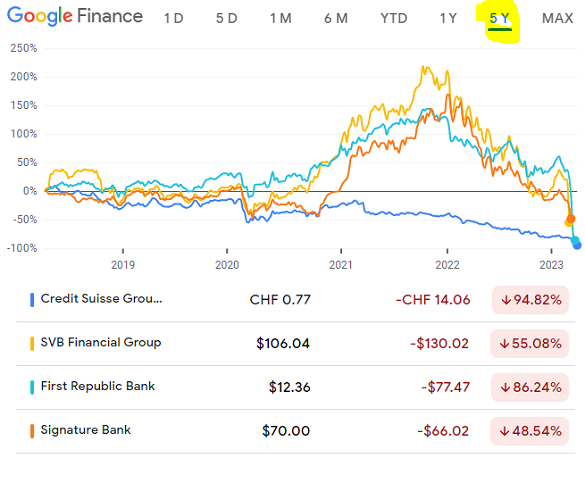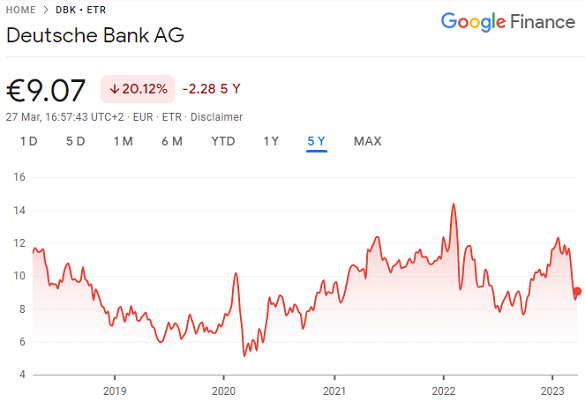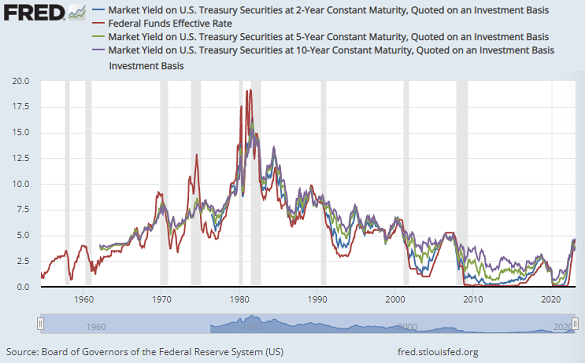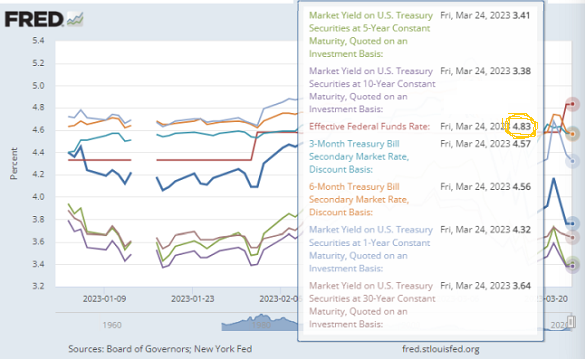Banking Crash? Fed Just Raised Rates Above Entire Treasury Yield Curve
Recession now racing this way says US bond market...
I'M NO FAN of 19th Century doorstoppers running to hundreds of pages with a cast of thousands, writes Adrian Ash at BullionVault in this note first shared with readers of the Weekly Update email on Monday.
But even if you've never read Anna Karenina, you probably know the opening line, if not the sad ending:
"Happy families are all alike; every unhappy family is unhappy in its own way."
Now, being a financial pundit in need of an opening line today, I wanted to spin this for the banking sector here in spring 2023.
But writers on deadline rarely stumble across unique ideas, and someone smarter than me just cut to the chase...
...asking Microsoft's ChatGPT for help:
"All well-run banks are alike; each poorly run bank is poorly run in its own way."
I, for one, welcome our new robot overlords. So let's go with that.
Just how poorly-run were the banks to fail so far or face collapse in this 2023 scare?

Roughly speaking, a bank takes in deposits while making loans.
To turn a profit, it just needs to pay less interest on the deposits than it charges on the loans.
Simple, right? Apparently not.
Silicon Valley Bank
Took in too much cash from too many tech start-ups who were flush with money and didn't need any loans.
So to generate income, SVB bought long-dated bonds, mostly US government debt. Those Treasury bonds are the safest thing in the financial world...up until they sank in price as inflation jumped and the Federal Reserve hiked interest rates at the fastest pace in pretty much ever.
Net result? SVB's loans (to the government) weren't worth what its depositors were owed. Cue a run for the exits when "a small number" of venture capitalists took to WhatsApp and shouted 'Fire!'.
Signature Bank
Lent money on New York real estate (among other things) while taking in lots of cash from crypto firms, even building them a payments platform (called Signet) so that the crypto firms' customers could turn magic beans into real Dollars 24/7.
Like SVB, that 'concentration risk' of too many customers all in the same business all at the same time meant that its depositors all started needing their money back when interest rates rose and crushed crypto. Lots of its borrowers suddenly started looking flaky for the very same reason.
Cue a rush for the exits, again led by bigger depositors spotting that they might need but hadn't got a government guarantee. Because, to quote Investopedia, "Signet required a minimum account balance of $250,000; FDIC insurance caps out at $250,000."
First Republic
Had a lot of deposits bigger than the US insurance limit, again making it vulnerable to a rush for the exits if people started to worry. It then parked a lot of those deposits in long-term bonds, suffering a steep loss of value as bond prices sank so that yields could rise alongside short-term interest rates.
Cue a rush for the exits because, well, just because. FRC's financial results for 2022, released in mid-January, actually looked pretty strong at first glance...
..."another terrific year of safe, consistent and organic growth" according to its CEO.
But with over 2/3rds of the money it held on deposit uninsured by the FDIC guarantee, that cash still ran for the door, and the share price slumped, as the banking scare took hold and spread.
No, it doesn'y help that news of massive salaries for the founder, his brother-in-law and his son is now coming out. And it really doesn't help that the $30bn which 11 major US institutions put on deposit at FRC as a (government-driven) show of confidence did nothing to stem the share price slump last week.
Credit Suisse
Very much bigger than the first two US casualties or crisis-hit FRC above, so it's harder to summarise. But in short, CS was just very badly run...flailing its way through any number of scandals, swapping its CEO, announcing a whole new plan, spooking its investors, and managing to make a monster loss in 2022 of more than $7 billion, pretty much equal to what its Swiss rival (and now owner) UBS made in profit.
Scandals weren't new at CS however, and it was far from alone in scandalous banking. But a rush for the exits started last autumn, with depositors pulling out $120bn in Oct-Dec alone. The coup de grace then came 2 weeks ago, when the boss of the bank's biggest investor...Saudi Arabia's state-owned Saudi National Bank...said "No, absolutely not" when asked if he would stump up any more cash to keep it in business. (He has since 'resigned' for 'personal reasons'.)
Contra Count Tolstoy then, a couple of common points stand out at these unhappy banks.
First, concentration risk: Is your bank serving all the same type of customers, whether on its loans or deposits? Just as importantly, how much of the deposits aren't covered by insurance? Big money runs fastest.
Second, regulatory pushback or failings: Credit Suisse kept blotting its copybook, while both Silicon Valley and Signature wanted to avoid the hassle and costs involved in the rules and oversight of becoming a very big bank worth more than $50 billion...a level set by the post-financial crisis Dodd-Frank Act. But rather than capping their size, they lobbied to get the threshold raised! The Trump administration obliged in 2018, raising the minimum level for "enhanced oversight" to $250bn.
Third, don't simply trust in longevity or brand. Credit Suisse was founded in 1856 and became synonymous with the stability, security and safety of the mountain-ringed nation. SVB had been around for almost 40 years, growing to become the 16th largest bank in the US by this New Year (but repeatedly telling lawmakers that it wasn't all that big really, and not big enough to warrant a big-bank regulation).
First Republic has been around since 1985, and while Signature had a more chequered history, it had grown since launch in 2001 to the 19th largest US bank, even bagging former Republican Barney Frank as a member of its board of directors.
(Yes, THAT Barney Frank, one half of the post-financial crisis' Dodd-Frank Act, which claimed to make US banks much safer by fighting the last war. He's now mad as hell that the feds shut down his bank and sold off its assets...well, those assets that anyone might want to buy...just because it threatened to spark a sector-wide panic.)
Okay, so that's the scare so far. What comes next?

"To be crystal clear...Deutsche is NOT the next Credit Suisse."
So said a research note picked up by pretty much every financial journalist late last week as shares in Germany's No.1 bank fell and fell again.
And in contrast to the flakier little banks above, Deutsche says that 76% of its German retail deposits are covered by the Eurozone and German government insurance schemes, with 1/3rd of its total deposits covered worldwide.
Moreover, as the Wall Street Journal says, "The bank is solidly profitable, has the strongest capital ratios since the late 1990s, and has lower interest-rate risk than some US regional banks.
"[So while] Deutsche Bank itself is also no stranger to tough times, it is far more advanced in its turnaround than Credit Suisse was when confidence evaporated."
For now the gold market seems to agree, easing back rapidly from last week's banking-scare peaks as the depositors' rush for the exits takes a breather and European and US banking shares rally.
Maybe this pause in fact marks the end, and the 2023 banking crisis will have lasted for just a few weeks in March. But some people said that about Bear Stearns 15 years ago, and even among the compliant, well-diversified and well-capitalized banks today, the real trouble hasn't yet hit.
Because the loan-book hasn't yet turned sour.

Squint hard enough at this chart and you can see how...every time a US economic recession is about to begin (as marked by the vertical dark grey bars)...the red line has risen above all the others.
That red line marks the US Fed's key interest rate, the Fed Funds rate. The other lines mark the annual yields offered to new buyers of 2-year, 5-year and 10-year US government bonds.
We could add the rate offered by 30-year or 12-month, 6-month or 3-month bills, too. It wouldn't matter. Those rates also went below the Fed's target interest rate just before a US recession began.
And for reference, following last week's action...
...when the Fed Funds rate was raised to a ceiling of 5.00% while the banking scare sent US bond yields sharply lower yet again...
...the Fed's key interest rate is now higher than the yield on any US Treasury bond or bill once again.
This kind of picture, where short-term rates come above longer-term rates, is known as an 'inverted yield curve'. Inverted because, more normally, long-term lenders get a bit more in annual interest than short-term lenders, to compensate for the extra time risk. And the gap between 10-year and 2-year US bond yields has now been inverted non-stop for 9 months, shouting "Recession!" at passers-by because it suggests that, sometime in the future, US interest rates will need to fall.
The track record of the 10-2 measure isn't perfect, however. It's called recession a little more often that a US recession has actually followed. But it's now half-a-year since the 10-year minus 3-month yield curve also flipped negative, and now that the Fed's overnight rate stands above every yield you can get from a US Treasury bond, note or bill, the market is screaming "Recession!" like no time since, well, the eve of the last economic downturn.
Whatever the mechanism or process by which an inverted yield curve turns into an economic downturn, this feature...where the Fed raises its interest rate above anything offered in the Treasury debt market...has preceded each of the last 8 recessions in the world's largest economy, including (weirdly) even the Covid Crash of 2020.
It's just happened again. And some poorly-run banks were already in trouble.

"There's something wrong! The bank won't give someone their money," says a lady queuing at the bank in Mary Poppins, half-hearing a commotion about tuppence belonging to a child.
"Well I'm going to get mine!" says the lady next to her. And so begins the near-collapse of the Fidelity Fiduciary Bank.
It all sounded quaint and Victorian back in 2007 when Northern Rock failed, and it seemed absurd when Bear Stearns went in March 2008, nine months after it made the headlines over the pile of toxic debt derivatives it held. But in the week ending Wednesday 15 March 2023, depositors at smaller US banks pulled out a record $107bn from their accounts...
...almost what global giant Credit Suisse lost in the last 3 months of 2022 combined.
In the final analysis, a banking run means that depositors...right or wrong...fear that the bank's debtors aren't going to repay their loans, leaving the bank without enough cash to repay its savers.
This bad genie is now freed from his bottle once more. Loans across Western banking markets haven't yet started to sour. But the bond market says a US recession is racing towards us.
Y'know, like a steam train.









 Email us
Email us